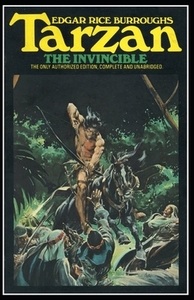Take a photo of a barcode or cover
Not always politically correct by today's standards but still always a bit of fun.
Tarzan’s monkey friend Nkima accidentally discovers something wrong in the jungle. He seeks out Tarzan and leads him to what turns out to be a group of communists intent on raiding the lost city of Opar for its gold. Additionally, the ruler and high priestess of the city, Queen La, is no longer in control and is in fact, a prisoner of the citizens of Opar. Tarzan has his work cut out for him if he wants to get things back in order.
This 14th novel in the Tarzan series was originally serialized in the magazine "Blue Book" from October 1930 through April 1931 as "Tarzan, Guard of the Jungle". That’s a good title as it perfectly describes Tarzan’s role here, as a guardian of all he holds dear. It follows upon the heels of his adventures in Pellucidar, ([b:Tarzan at the Earth's Core|338584|Tarzan at the Earth's Core (Tarzan, #13; Pellucidar, #4)|Edgar Rice Burroughs|https://i.gr-assets.com/images/S/compressed.photo.goodreads.com/books/1388533107l/338584._SY75_.jpg|86971538]). After a string of stories in which Tarzan visits lost cities, cultures, and locales, this book now returns to the rather familiar place of Opar. In fact, this book is the last ERB-authored one to feature Opar and the lovely La, unless you count the juvenile piece [b:Tarzan and the Tarzan Twins with Jad-bal-ja the Golden Lion|22747661|Tarzan and the Tarzan Twins with Jad-bal-ja the Golden Lion - The Original Classic Edition|Edgar Rice Burroughs|https://i.gr-assets.com/images/S/compressed.photo.goodreads.com/books/1405868236l/22747661._SY75_.jpg|13097964] which actually takes place before the events of this book.
The story is set amidst the backdrop of the growing Communist threat, although that seems to be mere window dressing when reading from this far future date. Rather, the story is a typically good Tarzan tale, filled with one adventure after another, as dictated by the original serial-form publication. Lion and leopard attacks, fist and knife fights, prison escapes, and more. Interestingly, Jane is not even mentioned, once again. The same thing happened in the Johnny Weissmuller movies, and I learned this was because audiences wanted Tarzan to not seem so tied down or domesticated. Other female characters would be introduced instead. Here, La remains in love with Tarzan, but Tarzan informs her he will never think that way about her.
I was pleased to see Tarzan's lion ally Jad-bal-ja, the Golden Lion himself, play a prominent role once again. Several nice additional characters were also well written, including two who seemed to be “Reds” but turned out to be fulfilling other, more espionage-type rolls. The bad guys were bad, and the good guys were, if not always “good”, certainly redeemable.
Ten more ERB Tarzan books to go. Let the countdown begin!
This 14th novel in the Tarzan series was originally serialized in the magazine "Blue Book" from October 1930 through April 1931 as "Tarzan, Guard of the Jungle". That’s a good title as it perfectly describes Tarzan’s role here, as a guardian of all he holds dear. It follows upon the heels of his adventures in Pellucidar, ([b:Tarzan at the Earth's Core|338584|Tarzan at the Earth's Core (Tarzan, #13; Pellucidar, #4)|Edgar Rice Burroughs|https://i.gr-assets.com/images/S/compressed.photo.goodreads.com/books/1388533107l/338584._SY75_.jpg|86971538]). After a string of stories in which Tarzan visits lost cities, cultures, and locales, this book now returns to the rather familiar place of Opar. In fact, this book is the last ERB-authored one to feature Opar and the lovely La, unless you count the juvenile piece [b:Tarzan and the Tarzan Twins with Jad-bal-ja the Golden Lion|22747661|Tarzan and the Tarzan Twins with Jad-bal-ja the Golden Lion - The Original Classic Edition|Edgar Rice Burroughs|https://i.gr-assets.com/images/S/compressed.photo.goodreads.com/books/1405868236l/22747661._SY75_.jpg|13097964] which actually takes place before the events of this book.
The story is set amidst the backdrop of the growing Communist threat, although that seems to be mere window dressing when reading from this far future date. Rather, the story is a typically good Tarzan tale, filled with one adventure after another, as dictated by the original serial-form publication. Lion and leopard attacks, fist and knife fights, prison escapes, and more. Interestingly, Jane is not even mentioned, once again. The same thing happened in the Johnny Weissmuller movies, and I learned this was because audiences wanted Tarzan to not seem so tied down or domesticated. Other female characters would be introduced instead. Here, La remains in love with Tarzan, but Tarzan informs her he will never think that way about her.
I was pleased to see Tarzan's lion ally Jad-bal-ja, the Golden Lion himself, play a prominent role once again. Several nice additional characters were also well written, including two who seemed to be “Reds” but turned out to be fulfilling other, more espionage-type rolls. The bad guys were bad, and the good guys were, if not always “good”, certainly redeemable.
Ten more ERB Tarzan books to go. Let the countdown begin!


